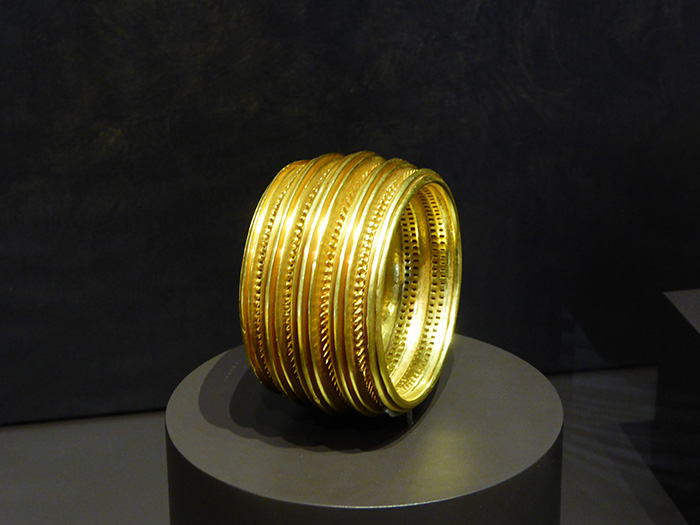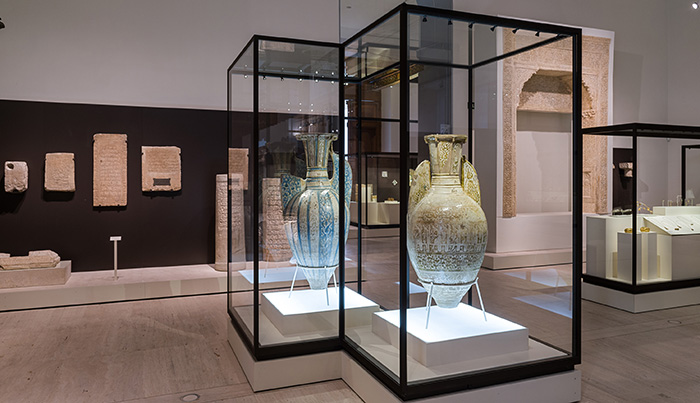
With prehistoric painted caves, ruins of Roman cities, spectacular places of worship converted during periods of conquest and reconquest, and elaborate palaces occupied by emirs and kings, Spain offers plenty of historic sites to explore. One place where you can get a flavor of this rich heritage across the length and breadth of the country under one roof is the National Archaeological Museum, founded in Madrid in 1867. Entering the museum space, visitors pass between two cabinets replete with objects that give a snapshot of Spain’s archaeological offerings. Beaker vessels mingle with Roman sculpture, medieval glazed pottery, and more. The myriad objects are then set into context with an introductory video and projections on a 3D map that outline the long and sometimes complex history of changing cultures and divisions of territory across the land. Even outside the museum, visitors are treated to a replica of one of Spain’s most prized archaeological discoveries. Head underground and you can see bison and other animals on a recreation of part of the Palaeolithic painted ceiling of the cave of Altamira, located in Cantabria in the north. Back inside, in the extensive prehistory galleries, more discoveries from caves abound. Some highlight other dimensions of Spain’s Palaeolithic art beyond the famous paintings. A Magdalenian ivory statuette found in a cave in Guadalajara, for instance, depicts a small carnivore, perhaps a wolverine. It is one of only a few sculptures in the round in Palaeolithic portable art known from Iberia.

The displays, roughly chronological, delve into many aspects of life in prehistory, such as exploiting resources, communal burials, and different types of pottery. From the Chalcolithic period, pottery decorated with motifs like deer, eyes, and suns (motifs which are also found in cave paintings and on idols) appear, interpreted as a sign of increasing specialisation. Bowls adorned with deer and radiating suns have been found, for example, in tombs at Los Millares. This Chalcolithic site in Andalucía was first excavated in the late 19th century by Luis Siret, a Belgian-born archaeologist who worked on a variety of sites in southern Spain that are represented in the museum. Remarkably, fragments of textiles woven from esparto grass – preserved for millennia in the Cave of Los Murcielagos, Granada – are on display too, giving a glimpse of the organic material world lost through time. Esparto grass from the cave has been dated to the Neolithic, though not all the objects in the museum were likely made during this time. Baskets and sandals were also found there. For the finely made baskets, fibres were dyed and then plaited. Inside some of these baskets were poppy seeds and locks of human hair. Surviving in greater numbers is the creation of Bronze Age metalworkers. One hoard, of Late Bronze Age gold found in Bodonal de la Sierra, Badajoz, contains objects quite rare in the Iberian Peninsula but related to jewellery found in the British Isles and Brittany, France. The spiralling pieces of gold from Bodonal de la Sierra are in the process of being cast, suggesting that they were imported as raw material to be worked in a local style. Nearby are pieces of completed gold jewellery, including a bracelet from Estremoz, Portugal, an exquisite example of Villena-Estremoz goldsmithing. Villena-Estremoz bracelets were made according to a complex method combining the use of a lathe, creating intricate openwork, and casting using the lost-wax process. There is more gold, this time in the form of ornate bowls, found one inside the other in the north in Axtroki, in the Basque Country. Recent suggestions are that these are not bowls, but – along with another example from Galicia – perhaps helmets or caps worn in rituals, with their decoration interpreted as solar symbols.

Fittingly for the Bronze Age, there are plenty of bronze artefacts too. In 1923, dredging work in the port of Huelva brought to light some 400 bronze objects, among them swords and spearheads, seemingly offered to the waters. This Late Bronze Age hoard is one of the largest underwater deposits known in western Europe. Such weapons are seen carved into stone in Spain’s stelae, including the slate ‘warrior stela’ from Solana de Cabanas, the first of these objects to be found (since its discovery in the 19th century, the count of these stelae is now at more than 100). The warrior on this stela is accompanied by a Mediterranean-style chariot; the placing of the wheels on the axis, the label points out, suggests the engraver had never seen a chariot. Making connections Gold similar to that used in the Late Bronze Age was still in use in Spain’s later centuries, when the Phoenicians had settled in southern Spain. A set of striking, tall gold objects, called the ‘candlesticks’ of Lebrija were made in the late 8th-early 7th century BC by local artisans, who combined the lathe and the lost-wax casting method. They represent a Phoenician deity, whose symbol may be a tree. Phoenician traders brought goods and imagery from other parts of the Mediterranean. They adapted Egyptian imagery of the pharaoh triumphing over his enemies to represent their god Baal, as can be seen in a gold medallion. And an early 5th-century BC Etruscan bone plaque depicting a sphinx (whose features show Greek influences) has been found on the island of Ibiza. Greek wares were imported, too, and found themselves, for example, in 4th-century BC burials of the Iberian culture. The increased demand in Spain for such products from North Africa, Etruria, and Greece led to local workshops producing copies and adaptations to suit local tastes. One interesting case of the merging of a foreign import and a local product is a Greek krater painted with a Dionysian scene that has been used as a cinerary urn and topped with a plain, and much lighter, Iberian lid. Similarly, even before Romans took hold of Spain, Italian products were in demand. Certain types of vessels became popular and were, again, copied and adapted with local styles of decoration. Much later, during the time of Al-Andalus, when much of the Iberian Peninsula was under Islamic rule as caliphates and independent principalities called taifas (with a few Christian kingdoms left in the north), items and new designs continued to come into Spain from far and wide. Among them is a 10th-century casket from Tunisia, finely decorated with polychrome ivory panels and a Kufic inscription, and a glazed inkwell of Persian origin. Together with examples of architectural decoration, such as a plaster frieze from Zaragoza’s Aljafería palace, these later exhibits reflect Spain’s many cultural connections over the centuries.

